Harold Bride
Wireless Operator
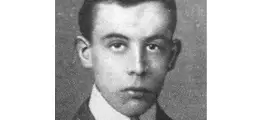
“Bride was washed off the deck-house at the same time as Murdoch and Murdoch was lying motionless in the water when Bride last saw him. Bride did tell Ernie that Murdoch would never have shot anyone.”
According to Edkins, “when Ernest Robinson interviewed Harold Bride in his home at Glasserton near Port William and in Glasgow 1954 – 1955, Bride confirmed, according to Robinson, that he was alongside Murdoch at collapsible A. 'Bride was washed off the deck-house at the same time as Murdoch and Murdoch was lying motionless in the water when Bride last saw him. Bride did tell Ernie that Murdoch would never have shot anyone'.” (Richard Edkins, Murdoch of the Titanic (1.)). However, no transcript of the interview has been made available for analysis at present.
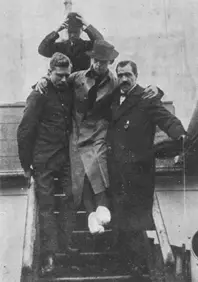
Due to injury to his legs Bride is
assisted as he departs the
Carpathia in New York.
(Click image to enlarge)
Harold Bride is –in addition to his role as Titanic’s junior wireless operator- also famous for his testimony regarding the last piece of music played by Titanic’s orchestra. He alleges that they played “Autumn” (possibly indicating “Songe d’automne”) rather than the popularly accepted “Nearer My God To Thee”. He is the only survivor who recalls “Autumn” and most Titanic historians feel evidence is weighed in “Nearer”s favour, since 1/ most survivors recall it, 2/ Bride was probably underneath collapsible B at the time, 3/ “Songe” is difficult to play without music and 4/ Wallace Hartley, the bandleader, said “Nearer” would be the way he wanted to go and that it was one of his favourite hymns.
Director James Cameron, when interviewed by Randall Frakes in the book James Cameron’s Illustrated Screenplay also points out that Bride was “paid a huge sum by The New York Times to tell his exclusive story. He’s the only person who said he thought he heard ‘Autumn’ and he had a reputation of being a young braggart who liked to elaborate stories” (James Cameron’s Illustrated Screenplay p.17 (2.)). In James Cameron’s Titanic Explorer CD-ROM, it is also said regarding Bride: “The young man’s name became tarnished after he sold his story to a newspaper and delivered several conflicting accounts of his experience.” (41.)
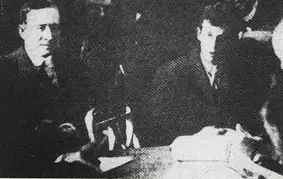
Despite his injuries Bride appeared during
the Senate inquiry.
Richard Edkins disagrees with the unreliability of Bride’s testimony. “The testimony of Second Wireless Operator Bride is particularly reliable because he was very honest. At the 1912 Board of Trade Inquiry and at the American inquiry under Senator Smith, he is reported as saying that he struck down a stoker trying to steal the lifejacket from First Wireless Operator Phillips. At that time, Phillips was desperately trying to send one final call for help, even though both men had been told to leave by Captain Smith himself. As Bride could have faced an action for murder for such an admission, it makes him almost painfully honest. The importance of his testimony is that it substantiates the evidence of Charles Herbert Lightoller, some of whose witness is coloured by his own prejudices towards individuals.” (Richard Edkins, Murdoch of the Titanic (1.))
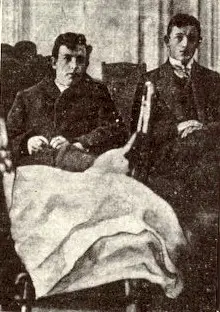
Bride during the United States
Senate inquiry.
But interestingly, on Day Two of the American Inquiry, Bride was interviewed by Senator Smith regarding his activities aboard Titanic and during intensive questioning does not once refer to working on the starboard side collapsible (as alleged in the Robinson interview). He only speaks of assisting with collapsible B on the port side, eventually ending up underneath the upturned lifeboat, staying underneath it for some time before climbing on top. It would be more logical for him to assist with a forward port side lifeboat since the wireless room was situated in among the officers’ quarters on the forward port side. Additionally, he only mentions “a collapsible boat on the top deck at the side of the forward funnel” speaking of a singular collapsible and not of two. If he had assisted on both the port and starboard sides, surely he would have mentioned them in the plural sense.
In reviewing the many accounts as to how he escaped from Titanic (notably The New York Times article of April 19, his testimony at the United States Inquiry on April 20, the testimony at the British Inquiry on April 23 and his report to the Marconi Company on April 27, 1912 - entered into the United States Inquiry of May 4) they all give a very similar story with no reference at all to being on the starboard side.
Even more interesting is Bride’s evidence regarding Titanic’s senior officers. In respect to a wireless message from the Californian that arrived at around 5pm, he was asked:
Smith: Who was the officer on the bridge?
Bride: I could not say, sir; I do not know the officers, sir…
Smith: Was it Mr. Lightoller?
Bride: I could not tell you.
Smith: You do not know whether it was the first or second officer?
Bride: I did not know any of the officers there; I did not know which watches they were keeping...
Smith: Was that officer Mr. Murdoch?
Bride: I could not tell you, sir.
Smith: Do you know Mr. Murdoch?
Bride: No, sir; I know the officers by sight, but I do not know their names.
Smith: Mr. Murdoch was first officer and he was in charge of the lookout at that time. Can you verify that in any way?
Bride: No, sir.
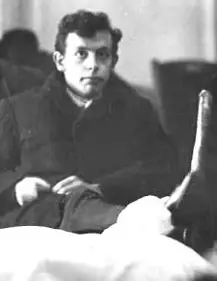
Bride giving testimony at the Senate
inquiry.
It is quite clear from this evidence that Harold Bride was unfamiliar with the officers and in particular with the identity of First Officer Murdoch. He is thus unqualified to comment on Murdoch’s activities, especially 42 years after the event (when interviewed in 1954). Even more so, he is no position to provide a character reference, in which “Murdoch would never have shot anyone”.
Bill Wormstedt provides a balanced view of this. He writes:
“It is possible that sometime between 1912 and 1955, Bride had become familiar with Murdoch’s face through photographs and recognized him at that point. It is also possible that the officer that Bride later thought was Murdoch, was actually Lightoller working on Collapsible B on the port, and Bride had confused the officer, and the side of the ship.” (Bill Wormstedt, Shots in the Dark (12.) )
Finally, on Day 14 Bride reads a report he has made to Mr. Cross, the traffic manager of the Marconi Co. to those present at the United States Inquiry:
“…leaving the cabin we climbed on top of the houses comprising the officers quarters and our own, and here I saw the last of Mr. Phillips, for he disappeared walking aft. I now assisted in pushing off a collapsible lifeboat, which was on the port side of the forward funnel, onto the boat deck. Just as the boat fell I noticed Captain Smith dive from the bridge into the sea. Then followed a general scramble down onto the boat deck, but no sooner had we got there than the sea washed over. I managed to catch hold of the boat we had previously fixed up and was swept overboard with her…”
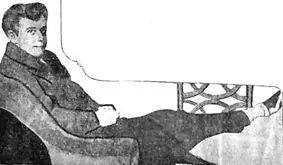
Bride was paid to provide a newspaper account
of his experience.
There is no mention of him ever being on the starboard side. Compound this evidence with the fact that Robinson interviewed Bride 42 – 43 years after the disaster (when Bride is aged around 65) and one could question whether his evidence is completely reliable (though Robinson’s account is no doubt trustworthy). In the monograph First Officer Murdoch and the ‘Dalbeattie Defense’ author George Behe requested Titanic historian Don Lynch’s opinion on the apparent contradiction between Bride’s evidence in 1912 and 1954. Lynch replied:
“In the course of my research and writing Titanic -An Illustrated History I encountered a number of examples where I had testimony or accounts by survivors from 1912 as well as from years or decades later. It became apparent that the testimony and writings from 1912 were superior. These were obtained when the disaster was still fresh in their memories, and as a result were clearer, usually more detailed, and consistent with what other survivors wrote or recalled at the time. Whenever I had conflicting accounts by a survivor to deal with, I would use the earlier of the two. As Harold Bride’s interview in The New York Times and his testimony at both the Senate and British Inquiries were so specific that he assisted in launching Collapsible B from the port side, I would place no value on second-hand information based upon an interview with Bride which had occurred over four decades after the sinking.” (Don Lynch, courtesy of George Behe, First Officer Murdoch and the ‘Dalbeattie Defense’ (11.) )
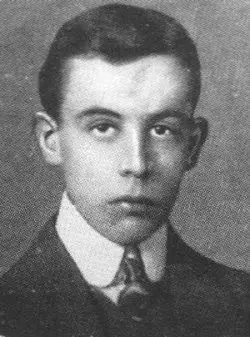
Bride's later account regarding Murdoch
is dubious at best.
Despite claims made in regard to Robinson’s interview of Bride, it seems rather certain that he was on the opposite side of the ship to Murdoch, in accordance with the testimony he gave at both the Senate and British Inquiries. Even if we were to assume that this was not the case, and that Bride had crossed from port to starboard and back to port (although all the evidence is against this) and that he last saw Murdoch “lying motionless in the water,” this does not conclusively rule out suicide, as no reason as to why Murdoch was seen lying dead in the water is given. Consequently, Bride’s account creates more confusion, does not give a clear answer as to what really occurred and fails to collaborate Lightoller’s evidence (as Richard Edkins hopes it would).